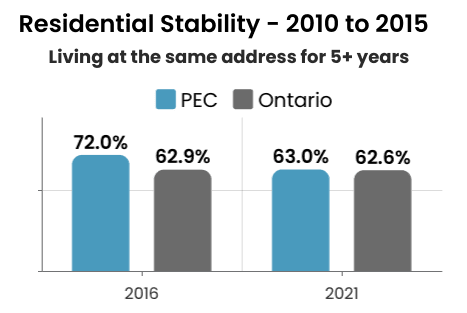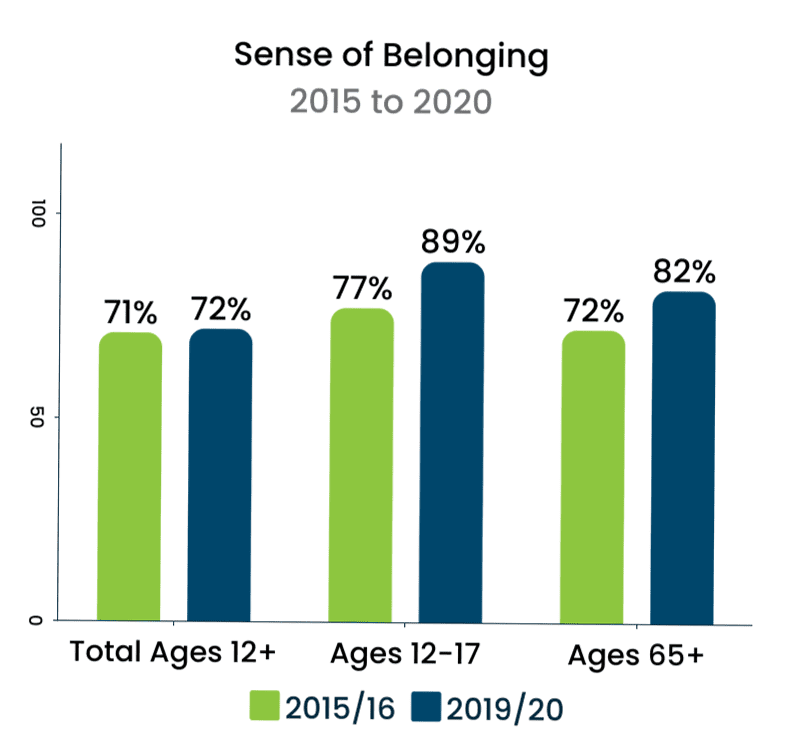Vital Signs Data
Sustainable Development Goals (SDGs)
SDG 11: Make communities inclusive, safe, resilient and sustainable.
SDG 16.7: Ensure responsive, inclusive, participatory and representative decision-making at all levels.

Sense of belonging
Sense of belonging
Hastings Prince Edward (HPE)
Seniors
HPE seniors have a strong sense of belonging at 82 percent, compared to their Ontario peers at 77 percent. This is perhaps influenced by the large seniors population, local attractive lifestyle opportunities and support services for mature residents. Prince Edward Community Care for Seniors reaches out to keep in touch with seniors and maintain a sense of connectedness and belonging.
Also see: The County of Prince Edward, Seniors, Age in Place
Youth
Loneliness and the Sense of Belonging
Social isolation and loneliness are increasingly being recognised as a priority public health problem and policy issue across all age groups. Experiencing loneliness or social isolation has been linked with a higher risk of premature death. (World Health Organization)
For seniors, Canada ranks as the loneliest among 11 developed countries in a recent Commonwealth Fund Survey of Older Adults—surpassing even the U.S. and U.K. Within this population, feelings of loneliness are most acute among women and those living alone. (Commonwealth Fund survey, 2021)
Understanding the Difference
Loneliness is the distressing feeling that arises when there is a gap between the social connections we want and what we actually experience.
Social isolation, on the other hand, refers to having few social relationships, roles, or group memberships, and limited interaction with others.
People can be socially connected and still feel lonely—or isolated without feeling lonely. But both experiences carry real risks.
The Human Need for Connection
Social connection is a basic human need, as vital to our survival as food, water, and shelter. Yet, many Canadians are struggling to meet this need:
- A Statistics Canada survey from 2021 found nearly one in every four young people aged 15-24 said they often felt lonely.
- According to the National Institute on Ageing, 41% of Canadians aged 50+ are socially isolated.
- In 2023, 39% of Canadians aged 65 and older reported feeling lonely at least some of the time (Canadian Social Survey).
Rates of reported loneliness more than doubled among older adults during the COVID-19 pandemic.
Who is Most at Risk?
Women and those living alone
Older adults with low income or living in disadvantaged areas
Single, widowed, or divorced individuals
Immigrants compared to Canadian-born residents
Indigenous Peoples, who face systemic barriers like poverty, trauma, and social exclusion
Health Impacts of Loneliness
Loneliness increases the risk of:
Heart disease and stroke
Hypertension
Dementia
Diabetes
Depression and anxiety
Premature death
It’s a public health crisis—often hidden, but deeply harmful.
Civic engagement promotes the quality of life in our community, through both political and non-political processes. Civic engagement includes both paid and unpaid forms of political activism, environmentalism, and community service.
Volunteerism
Volunteerism makes a significant difference in PEC, providing time and expertise to allow the operation of services and programs that could not otherwise be delivered.
Volunteerism is strongly related to the social vitality of our community, and supporting the basic needs of our vulnerable populations: most volunteer hours contribute to organizations related to sports and recreation, social services, education, religion, food banks, and health.
PEC’s aging population has been cited as a challenge in terms of retaining volunteers, but the senior volunteer base is supplemented by the inflow of highly experienced and skilled early retirees moving into PEC.
Statistics Canada (Nov/22) data shows that the majority of organizations in the nonprofit sector are facing challenges related to volunteerism; 67% report facing a shortage of new volunteers, 51% report challenges with retention, 42% report that volunteers aren’t able to commit long term, 29% lack time or resources to recruit volunteers and 26% report high volunteer burnout and stress. The data also shows the impacts that this is having on organizations: 28% report that paid employees are working more hours, 35% report a reduction of programs or services, 17% report cancellation of programs and services and 21% report employee burnout.
Traditional volunteering changed during the pandemic. Younger generation volunteers were more available and grassroots, online community networks like Care Mongering PEC helped neighbours support each other by performing tasks such as grocery shopping or drug store pick-ups.

- Get Connected directory: Explore the directory to find communities of interest, activities, volunteer opportunities, and more.
- Volunteer + Information Centre of Hastings and Prince Edward Counties refers volunteers to more than 275 agencies throughout the region.
Civic Engagement
A healthy democracy needs citizens who feel their votes count, are informed, participate, debate, and advocate. It needs governments at all levels to be transparent, inclusive, consultative, and trustworthy. In essence, political leadership, citizen participation, and communication demonstrate the level of democratic engagement. (University of Waterloo. Democratic engagement)
- Thrive PEC is a community-led development of a collaborative vision for the future of Prince Edward County. Join the conversation…
- Have Your Say, Prince Edward County’s municipal online engagement website, invites residents to follow issues, share ideas, give feedback, and join the conversation to help shape County projects. This is an opportunity for everyone to have their say.
- REPRESENT is an initiative to promote more balanced and reflective local government. It is a volunteer-run effort to connect, engage and support underrepresented people who are interested in participating in local government — women, First Nations and racialized people, gender diverse people, LGBTQIA2S people, people living with disabilities, and youth. For more information email representpec@gmail.com
- Accessible Council meetings: All meetings of Council are live streamed for the benefit of those residents and interested individuals that are not able to attend in person. All recorded meetings are also posted to the archives so that residents can view past meetings at their leisure.
- Citizen committees provide Council and staff with input about a wide variety of subjects through discussions, presentations and recommendations. Becoming a member of a citizen committee offers residents a unique chance to volunteer their highly valued skills and knowledge to strengthen our shared sense of community.
- Youth engagement: Prince Edward County is looking to develop meaningful civic engagement opportunities for young people, and is the first municipality in Eastern Ontario to join forces with the Youth Council Coalition of Canada. The County participates in the YCC’s Hour-for-Hour Challenge which helps secondary school students learn how local government works through experiential learning opportunities. Participating students can also use the time towards their required 40 hours of volunteer service. For more information contact Joy McLeod, Executive Assistant to the Mayor, by emailing jmcleod@pecounty.on.ca
Voter participation
Federal Electoral District: Bay of Quinte (Baie de Quinte)
This riding was created in 2012 by the federal electoral boundaries redistribution. The riding contains the municipalities of Prince Edward County, Quinte West (including CFB Trenton) and that part of Belleville south of Highway 401.
Provincial Electoral District: Bay of Quinte
This riding was created in 2015. It elects one member to the Legislative Assembly of Ontario. Ontario elections are held every 4 years on the first Thursday in June. The first election for this district was in 2018.
Municipal
Prince Edward is not a county by the standard Ontario definition — it is a single-tier municipal government with city status that handles all municipal services.
For the 2022 election, Council adopted a hybrid method of voting to support both online and in-person voting to improve the accessibility of voting for all residents in the County.
Voter participation
Local voters are most engaged at the federal level.
Federal Electoral District: BOQ Bay of Quinte (Baie de Quinte) since 2012
Provincial Electoral District: BOQ Bay of Quinte (Baie de Quinte) since 2015
AMO is the Association of Municipalities of Ontario
Residential Stability
Residential stability is an indicator of stability, investment, and connectivity to a neighbourhood. (Urban Institute. Family Residential Instability) It measures the percentage of the population that has remained at the same address for five or more years.
The rate of residential stability in PEC has decreased 9 percent between 2016 and 2021 (from 72% non-movers within 5 years down to 63%).

Inclusion
An inclusive community is welcoming to diverse groups of people, including seniors, youth, children, Indigenous peoples, immigrants and newcomers, gender diverse, persons with disabilities, people experiencing mental health challenges, and low-income populations. (Accessibility Canada, Pathways to Recreation)
Public health recognizes the strong relationship between the social determinants of health and health outcomes. Racism and employment are two key social determinants of health.
Changing sense of place
PEC is undergoing a changing sense of place. The majority of the population has historically been long-time residents, with many being descendants of the first European settlers to this island community. Permanent residents and businesses have been invested in the place-based economic ecosystem that relied heavily on agribusiness and seasonal tourism.
Shifting demographics in recent years are causing disruptions to the culture, housing market, available workforce and makeup of businesses. PEC’s proximity to large urban centres and the area’s natural beauty have attracted retirees, second-home buyers, and investors.
- PEC is attractive to retirees − a third of the population is now aged 65+. While this age group continues to increase, the workforce and youth aged populations are decreasing.
- Between 2016-17, up to half of the home sales in PEC were attributed to new short-term accommodations (STAs). Some neighbourhoods have become “dark”, with a constant turnover of tourists and few permanent residents. Businesses cater more to the tourism market than to the needs of local residents.
- Since the Covid-19 pandemic in 2020/21, PEC’s housing market has felt the impact of increased homeowner demand with people from areas surrounding Toronto purchasing local properties where they can work remotely and live more affordably.
- The uptake of remote work has enabled more white-collar workers to move to PEC. Since they are already employed they don’t contribute to the local labour shortage.
- Pressure from developers and investors is resulting in “gentrification” of neighbourhoods and displacement of current residents.
- There is growing divisiveness between generational residents who are struggling with the cost of living, and newcomers to PEC. The financial divide is widening.
This “perfect storm” has resulted in a housing crisis due to the escalation of housing prices and depletion of housing inventory. Many young families, low-income earners and seniors can no longer afford to live here. Businesses are short-staffed and lack of affordable housing is a barrier to attracting employees and doctors. The over-tourism, housing crisis, and sense of loss of place are causing growing discord between long-time residents, visitors, and newcomers. New housing developments currently in the planning stages will further change the demographic mix.


